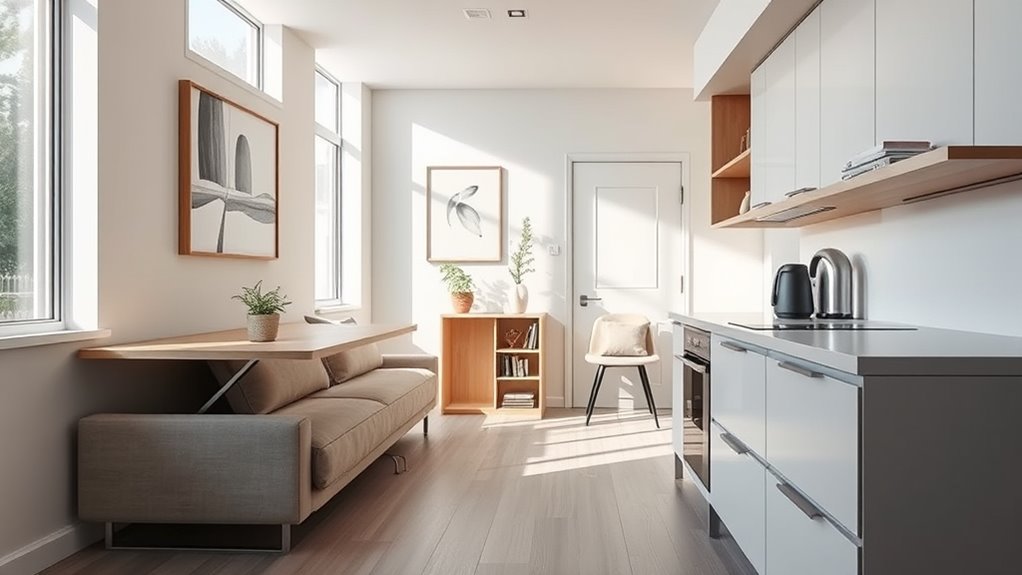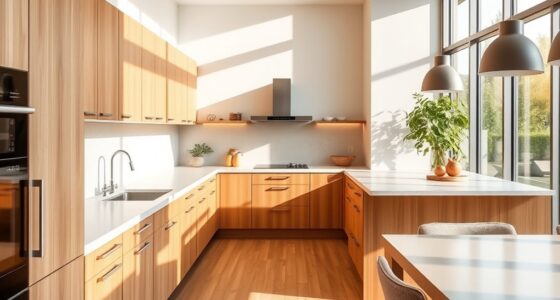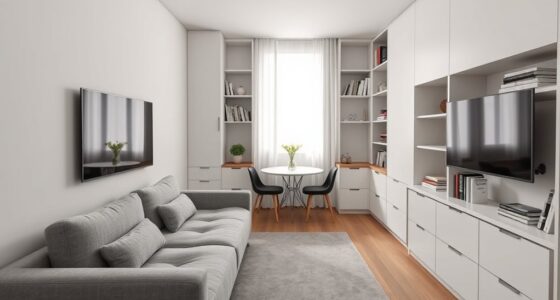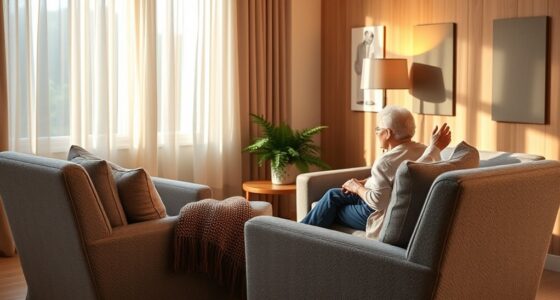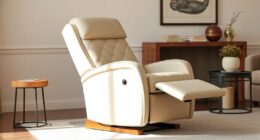When downsizing, focus on multi functional furniture that serves multiple purposes, like sofa beds or storage beds, to save space while adding functionality. Maximize vertical space with wall shelves and organizers, and use clever storage solutions like stacked containers or floating shelves to keep clutter at bay. Choosing proportionate furniture that adapts to your needs helps create a balanced, open feel. Keep exploring to discover more tips for making your small space comfortable and efficient.
Key Takeaways
- Incorporate multi functional furniture to maximize utility and reduce clutter in limited spaces.
- Utilize vertical storage solutions like wall-mounted shelves and floating units to free up floor space.
- Choose proportionate, adaptable furniture that fits the room size and serves multiple purposes.
- Enhance the space with smart design elements such as integrated technology and personalized storage options.
- Prioritize open layouts and cohesive decor to create an inviting, efficient, and personalized small living area.
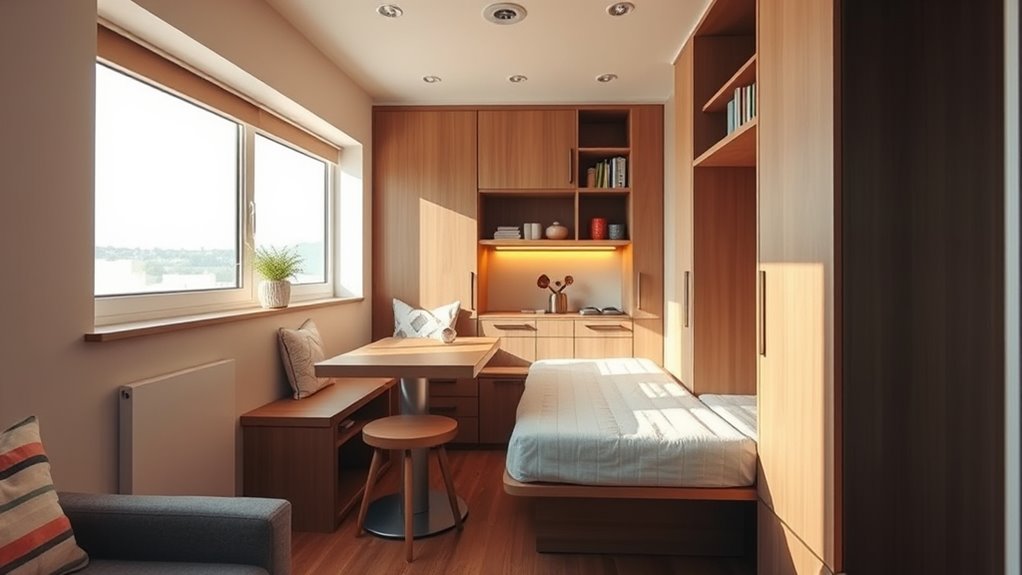
Ever wondered how to make the most of a small space? When you’re downsizing, every square foot counts, so it’s essential to think creatively about your layout. One of the smartest ways to do this is by investing in multi functional furniture. These versatile pieces are designed to serve more than one purpose, helping you maximize your space without sacrificing comfort or style. For example, a sofa bed allows you to have a comfortable seating area during the day and a cozy bed at night. A coffee table with built-in storage can hold books, blankets, or other essentials, reducing clutter and freeing up precious space. By choosing furniture that combines functions, you streamline your living area and create a more open, less congested environment.
Maximize small spaces with multi functional furniture that combines style, comfort, and clever storage solutions.
Maximizing storage is another critical aspect of designing for small spaces. You want to keep things organized and out of sight, so every piece of furniture should serve a dual purpose—like a bed with drawers underneath or wall-mounted shelves that utilize vertical space. Think vertically; walls are often underused areas that can hold shelves, hooks, or hanging organizers. Installing floating shelves above your desk or bed gives you extra storage without encroaching on floor space. Compact, stackable containers or baskets can neatly store everything from kitchen supplies to personal belongings, keeping clutter at bay while maintaining easy access. Additionally, integrating self-watering and waterless planters can help maintain greenery in limited spaces with minimal effort, enhancing your small space’s aesthetic and livability. Incorporating multi purpose furniture that is adaptable not only saves space but also adds flexibility for various activities. As you organize your environment, consider integrating smart home technology to optimize functionality and convenience in confined areas. Understanding and applying the Law of Attraction principles can also help you create a positive and inspiring environment that supports your lifestyle goals. Making sure that your furniture and storage solutions are customizable allows for further personalization and adaptation as your needs change. Remember, the key is to select storage solutions that blend seamlessly with your decor, so your space feels cohesive and not cramped.
Another way to maximize your small space is by choosing furniture that’s proportionate to your room. Avoid oversized pieces that dominate the area; instead, opt for scaled-down versions that fit comfortably. Multi functional furniture is especially valuable here because it allows you to have the essentials without overwhelming the room. Multi purpose beds, fold-out desks, and extendable tables can adapt to your needs, whether you’re working, relaxing, or entertaining guests. When you’re designing a small space, think of every piece as a tool to make your life easier and your environment more efficient. Use multi functional furniture as your foundation, and complement it with clever storage solutions to keep everything organized and accessible.
In the end, successful downsizing isn’t just about fitting everything into a smaller area—it’s about creating a space that feels open, functional, and personalized. By focusing on multi functional furniture and maximizing storage, you’ll transform your small space into a comfortable haven that works perfectly for your lifestyle.
Frequently Asked Questions
How Can I Maximize Storage Without Cluttering My Small Space?
To maximize storage without clutter, consider using hidden compartments to keep items out of sight and maintain a clean look. Incorporate vertical storage solutions like tall shelves or wall-mounted units to free up valuable floor space. You can also use multi-functional furniture, such as beds with drawers or fold-away desks, to optimize every inch. These strategies help you keep your small space organized and visually spacious.
What Color Schemes Make Small Rooms Feel Larger?
Imagine sunlight bouncing off a soft, airy blue wall, instantly making your room feel more expansive. Light, neutral colors with subtle color contrast work wonders for small rooms, creating an open feel. Accent walls in calming shades add depth without overwhelming the space. You’ll find that these color schemes reflect light and enhance your room’s size, making it feel brighter and more inviting effortlessly.
Are Multi-Purpose Furniture Pieces Worth the Investment?
Multi-purpose furniture like convertible beds and fold-away tables are definitely worth the investment. They help you maximize space without sacrificing functionality, making your small room more versatile. You can easily transform a living area into a bedroom or dining space when needed. These pieces save space and add convenience, making your small home more comfortable and practical. Overall, investing in multi-purpose furniture is a smart move for efficient living.
How Do I Create Privacy in Small Shared Living Areas?
Think of your shared space as a symphony needing balance. To create privacy, use clever solutions like privacy screens that define personal zones without closing them off completely. Incorporate soundproofing techniques, such as rugs, wall panels, or curtains, to lessen noise and enhance separation. These strategies help you carve out your own sanctuary, making small shared areas feel more private and comfortable without sacrificing style or openness.
What Lighting Options Enhance Small Space Functionality?
To enhance small space functionality with lighting, you should focus on versatile options like LED accent and task lighting. Use LED accent lights to highlight features and create ambiance without occupying much space. Incorporate task lighting in areas like your kitchen or workspace to improve visibility and efficiency. Combining these lighting types ensures your small space is both functional and inviting, making every inch work for you.
Conclusion
As you embrace small space living, remember that smart design can maximize every square inch. Studies show that 78% of tiny homeowners report feeling more organized and relaxed in their optimized spaces. By choosing multifunctional furniture and clever storage solutions, you turn limited square footage into a comfortable, stylish haven. Downsizing isn’t about sacrificing comfort but about creating a functional, inviting environment that truly works for you. With thoughtful design, small spaces can feel surprisingly expansive and welcoming.
